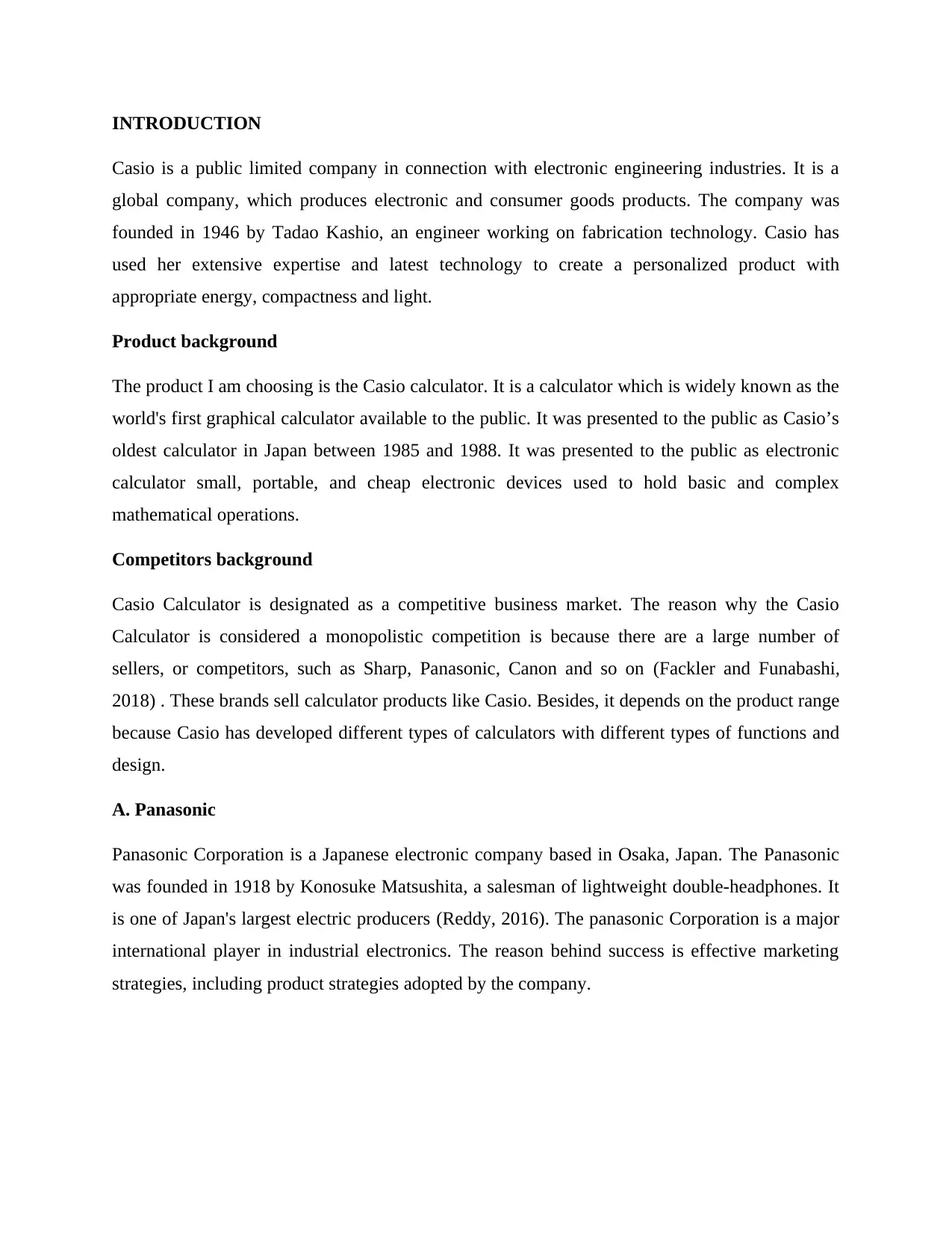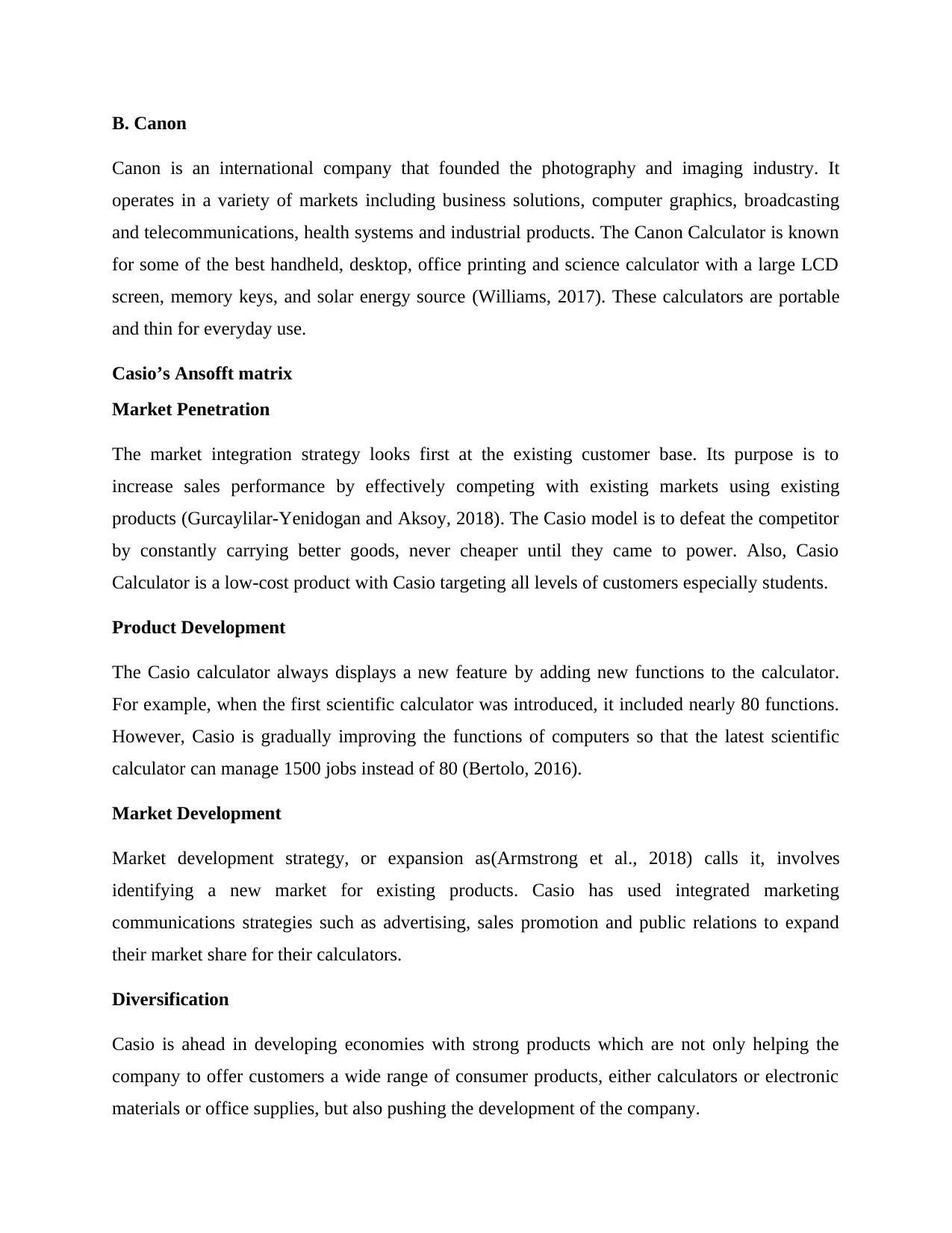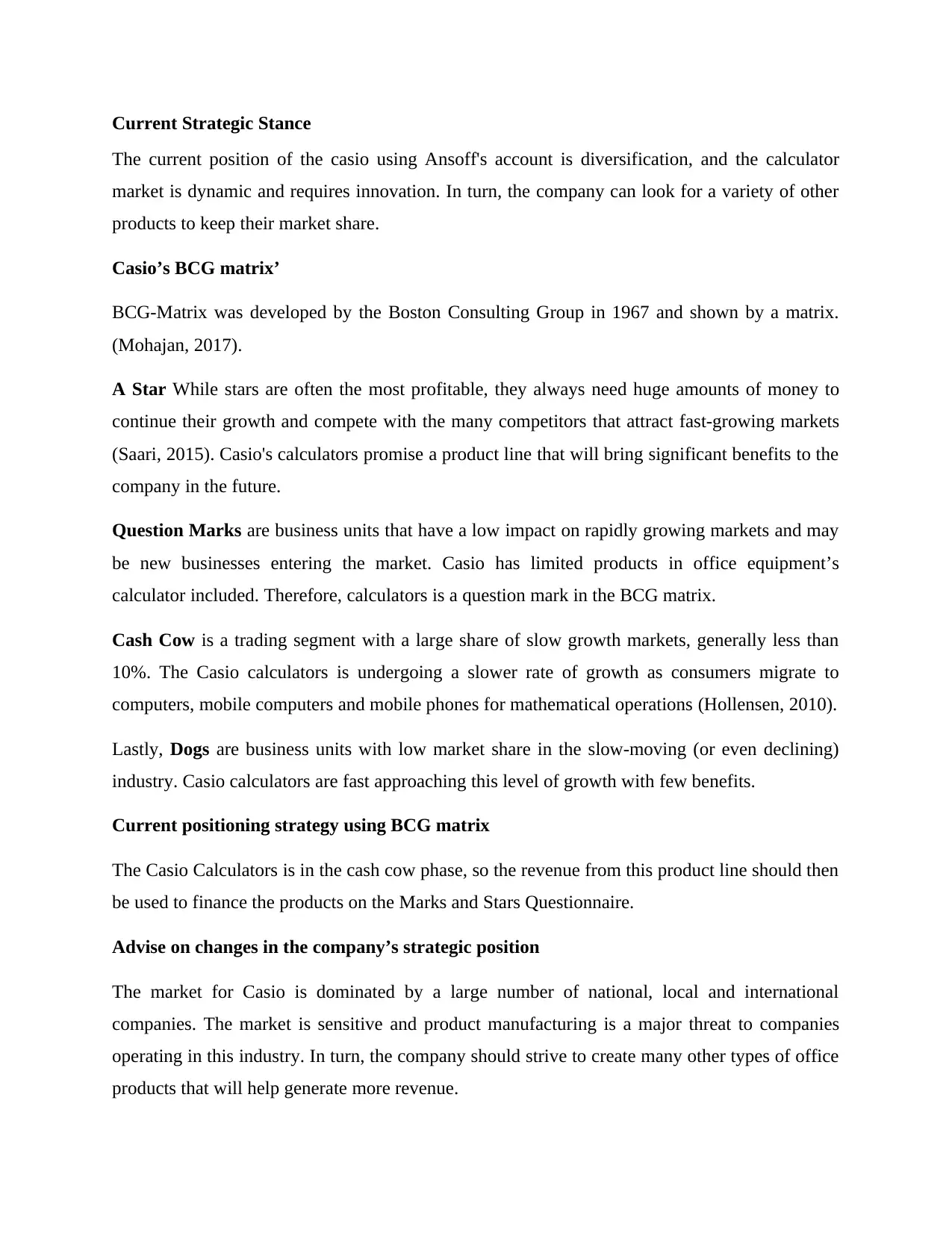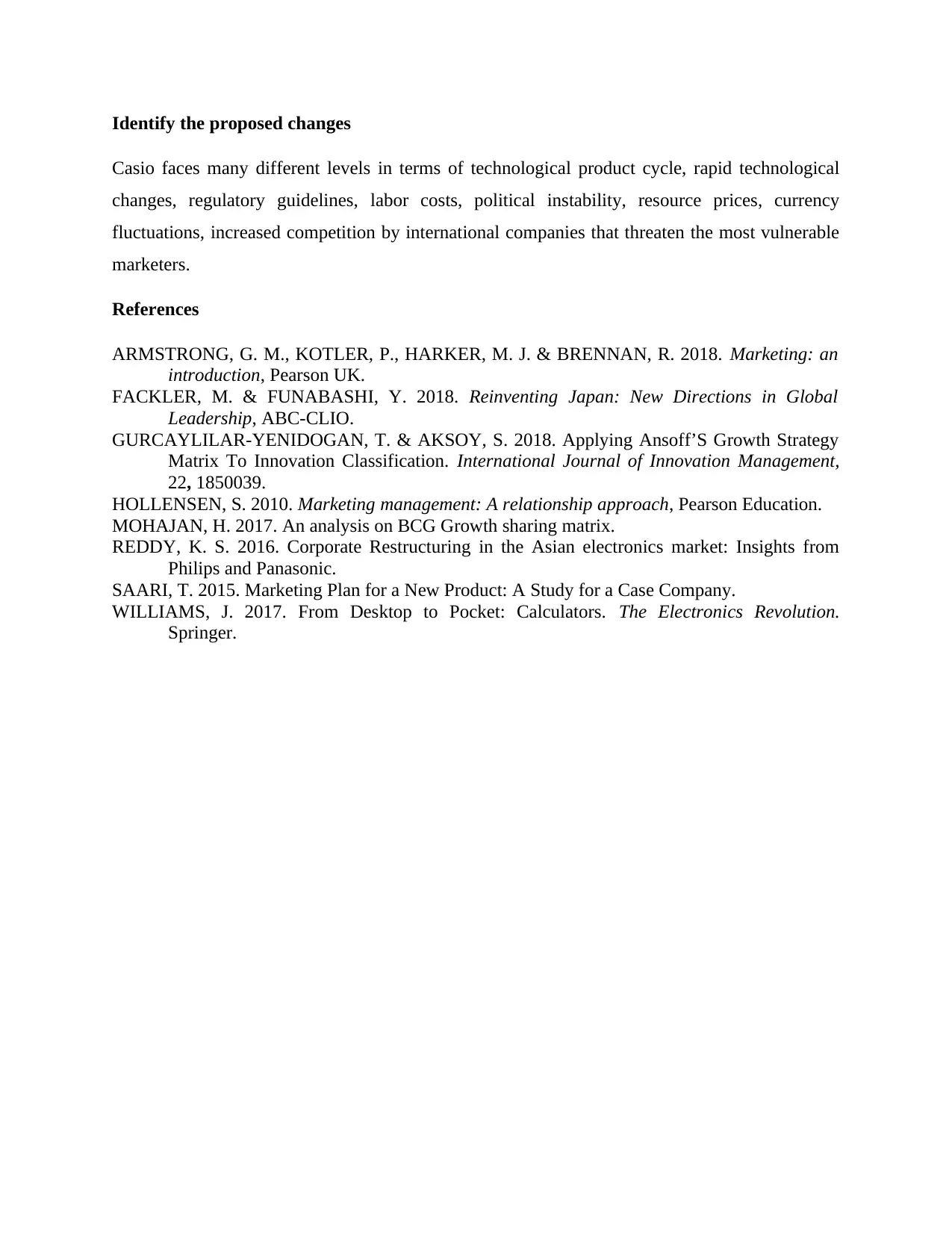Strategic Analysis and Positioning of Casio Calculator Products
VerifiedAdded on 2022/10/06
|4
|1216
|23
Report
AI Summary
This report provides a comprehensive strategic analysis of the Casio calculator market, examining its current position, competitive landscape, and growth strategies. It begins with an introduction to Casio, its product background, and key competitors like Panasonic and Canon. The analysis delves into Casio's market penetration, product and market development strategies, and diversification efforts using Ansoff's matrix. The report then applies the BCG matrix to assess Casio's calculator product line, classifying it as a Cash Cow and suggesting strategic moves. Finally, it identifies proposed changes and challenges Casio faces, including technological advancements and increased competition, offering recommendations for future strategic positioning. The report references relevant academic sources to support its findings and recommendations.

INTRODUCTION
Casio is a public limited company in connection with electronic engineering industries. It is a
global company, which produces electronic and consumer goods products. The company was
founded in 1946 by Tadao Kashio, an engineer working on fabrication technology. Casio has
used her extensive expertise and latest technology to create a personalized product with
appropriate energy, compactness and light.
Product background
The product I am choosing is the Casio calculator. It is a calculator which is widely known as the
world's first graphical calculator available to the public. It was presented to the public as Casio’s
oldest calculator in Japan between 1985 and 1988. It was presented to the public as electronic
calculator small, portable, and cheap electronic devices used to hold basic and complex
mathematical operations.
Competitors background
Casio Calculator is designated as a competitive business market. The reason why the Casio
Calculator is considered a monopolistic competition is because there are a large number of
sellers, or competitors, such as Sharp, Panasonic, Canon and so on (Fackler and Funabashi,
2018) . These brands sell calculator products like Casio. Besides, it depends on the product range
because Casio has developed different types of calculators with different types of functions and
design.
A. Panasonic
Panasonic Corporation is a Japanese electronic company based in Osaka, Japan. The Panasonic
was founded in 1918 by Konosuke Matsushita, a salesman of lightweight double-headphones. It
is one of Japan's largest electric producers (Reddy, 2016). The panasonic Corporation is a major
international player in industrial electronics. The reason behind success is effective marketing
strategies, including product strategies adopted by the company.
Casio is a public limited company in connection with electronic engineering industries. It is a
global company, which produces electronic and consumer goods products. The company was
founded in 1946 by Tadao Kashio, an engineer working on fabrication technology. Casio has
used her extensive expertise and latest technology to create a personalized product with
appropriate energy, compactness and light.
Product background
The product I am choosing is the Casio calculator. It is a calculator which is widely known as the
world's first graphical calculator available to the public. It was presented to the public as Casio’s
oldest calculator in Japan between 1985 and 1988. It was presented to the public as electronic
calculator small, portable, and cheap electronic devices used to hold basic and complex
mathematical operations.
Competitors background
Casio Calculator is designated as a competitive business market. The reason why the Casio
Calculator is considered a monopolistic competition is because there are a large number of
sellers, or competitors, such as Sharp, Panasonic, Canon and so on (Fackler and Funabashi,
2018) . These brands sell calculator products like Casio. Besides, it depends on the product range
because Casio has developed different types of calculators with different types of functions and
design.
A. Panasonic
Panasonic Corporation is a Japanese electronic company based in Osaka, Japan. The Panasonic
was founded in 1918 by Konosuke Matsushita, a salesman of lightweight double-headphones. It
is one of Japan's largest electric producers (Reddy, 2016). The panasonic Corporation is a major
international player in industrial electronics. The reason behind success is effective marketing
strategies, including product strategies adopted by the company.
Paraphrase This Document
Need a fresh take? Get an instant paraphrase of this document with our AI Paraphraser

B. Canon
Canon is an international company that founded the photography and imaging industry. It
operates in a variety of markets including business solutions, computer graphics, broadcasting
and telecommunications, health systems and industrial products. The Canon Calculator is known
for some of the best handheld, desktop, office printing and science calculator with a large LCD
screen, memory keys, and solar energy source (Williams, 2017). These calculators are portable
and thin for everyday use.
Casio’s Ansofft matrix
Market Penetration
The market integration strategy looks first at the existing customer base. Its purpose is to
increase sales performance by effectively competing with existing markets using existing
products (Gurcaylilar-Yenidogan and Aksoy, 2018). The Casio model is to defeat the competitor
by constantly carrying better goods, never cheaper until they came to power. Also, Casio
Calculator is a low-cost product with Casio targeting all levels of customers especially students.
Product Development
The Casio calculator always displays a new feature by adding new functions to the calculator.
For example, when the first scientific calculator was introduced, it included nearly 80 functions.
However, Casio is gradually improving the functions of computers so that the latest scientific
calculator can manage 1500 jobs instead of 80 (Bertolo, 2016).
Market Development
Market development strategy, or expansion as(Armstrong et al., 2018) calls it, involves
identifying a new market for existing products. Casio has used integrated marketing
communications strategies such as advertising, sales promotion and public relations to expand
their market share for their calculators.
Diversification
Casio is ahead in developing economies with strong products which are not only helping the
company to offer customers a wide range of consumer products, either calculators or electronic
materials or office supplies, but also pushing the development of the company.
Canon is an international company that founded the photography and imaging industry. It
operates in a variety of markets including business solutions, computer graphics, broadcasting
and telecommunications, health systems and industrial products. The Canon Calculator is known
for some of the best handheld, desktop, office printing and science calculator with a large LCD
screen, memory keys, and solar energy source (Williams, 2017). These calculators are portable
and thin for everyday use.
Casio’s Ansofft matrix
Market Penetration
The market integration strategy looks first at the existing customer base. Its purpose is to
increase sales performance by effectively competing with existing markets using existing
products (Gurcaylilar-Yenidogan and Aksoy, 2018). The Casio model is to defeat the competitor
by constantly carrying better goods, never cheaper until they came to power. Also, Casio
Calculator is a low-cost product with Casio targeting all levels of customers especially students.
Product Development
The Casio calculator always displays a new feature by adding new functions to the calculator.
For example, when the first scientific calculator was introduced, it included nearly 80 functions.
However, Casio is gradually improving the functions of computers so that the latest scientific
calculator can manage 1500 jobs instead of 80 (Bertolo, 2016).
Market Development
Market development strategy, or expansion as(Armstrong et al., 2018) calls it, involves
identifying a new market for existing products. Casio has used integrated marketing
communications strategies such as advertising, sales promotion and public relations to expand
their market share for their calculators.
Diversification
Casio is ahead in developing economies with strong products which are not only helping the
company to offer customers a wide range of consumer products, either calculators or electronic
materials or office supplies, but also pushing the development of the company.

Current Strategic Stance
The current position of the casio using Ansoff's account is diversification, and the calculator
market is dynamic and requires innovation. In turn, the company can look for a variety of other
products to keep their market share.
Casio’s BCG matrix’
BCG-Matrix was developed by the Boston Consulting Group in 1967 and shown by a matrix.
(Mohajan, 2017).
A Star While stars are often the most profitable, they always need huge amounts of money to
continue their growth and compete with the many competitors that attract fast-growing markets
(Saari, 2015). Casio's calculators promise a product line that will bring significant benefits to the
company in the future.
Question Marks are business units that have a low impact on rapidly growing markets and may
be new businesses entering the market. Casio has limited products in office equipment’s
calculator included. Therefore, calculators is a question mark in the BCG matrix.
Cash Cow is a trading segment with a large share of slow growth markets, generally less than
10%. The Casio calculators is undergoing a slower rate of growth as consumers migrate to
computers, mobile computers and mobile phones for mathematical operations (Hollensen, 2010).
Lastly, Dogs are business units with low market share in the slow-moving (or even declining)
industry. Casio calculators are fast approaching this level of growth with few benefits.
Current positioning strategy using BCG matrix
The Casio Calculators is in the cash cow phase, so the revenue from this product line should then
be used to finance the products on the Marks and Stars Questionnaire.
Advise on changes in the company’s strategic position
The market for Casio is dominated by a large number of national, local and international
companies. The market is sensitive and product manufacturing is a major threat to companies
operating in this industry. In turn, the company should strive to create many other types of office
products that will help generate more revenue.
The current position of the casio using Ansoff's account is diversification, and the calculator
market is dynamic and requires innovation. In turn, the company can look for a variety of other
products to keep their market share.
Casio’s BCG matrix’
BCG-Matrix was developed by the Boston Consulting Group in 1967 and shown by a matrix.
(Mohajan, 2017).
A Star While stars are often the most profitable, they always need huge amounts of money to
continue their growth and compete with the many competitors that attract fast-growing markets
(Saari, 2015). Casio's calculators promise a product line that will bring significant benefits to the
company in the future.
Question Marks are business units that have a low impact on rapidly growing markets and may
be new businesses entering the market. Casio has limited products in office equipment’s
calculator included. Therefore, calculators is a question mark in the BCG matrix.
Cash Cow is a trading segment with a large share of slow growth markets, generally less than
10%. The Casio calculators is undergoing a slower rate of growth as consumers migrate to
computers, mobile computers and mobile phones for mathematical operations (Hollensen, 2010).
Lastly, Dogs are business units with low market share in the slow-moving (or even declining)
industry. Casio calculators are fast approaching this level of growth with few benefits.
Current positioning strategy using BCG matrix
The Casio Calculators is in the cash cow phase, so the revenue from this product line should then
be used to finance the products on the Marks and Stars Questionnaire.
Advise on changes in the company’s strategic position
The market for Casio is dominated by a large number of national, local and international
companies. The market is sensitive and product manufacturing is a major threat to companies
operating in this industry. In turn, the company should strive to create many other types of office
products that will help generate more revenue.
⊘ This is a preview!⊘
Do you want full access?
Subscribe today to unlock all pages.

Trusted by 1+ million students worldwide

Identify the proposed changes
Casio faces many different levels in terms of technological product cycle, rapid technological
changes, regulatory guidelines, labor costs, political instability, resource prices, currency
fluctuations, increased competition by international companies that threaten the most vulnerable
marketers.
References
ARMSTRONG, G. M., KOTLER, P., HARKER, M. J. & BRENNAN, R. 2018. Marketing: an
introduction, Pearson UK.
FACKLER, M. & FUNABASHI, Y. 2018. Reinventing Japan: New Directions in Global
Leadership, ABC-CLIO.
GURCAYLILAR-YENIDOGAN, T. & AKSOY, S. 2018. Applying Ansoff’S Growth Strategy
Matrix To Innovation Classification. International Journal of Innovation Management,
22, 1850039.
HOLLENSEN, S. 2010. Marketing management: A relationship approach, Pearson Education.
MOHAJAN, H. 2017. An analysis on BCG Growth sharing matrix.
REDDY, K. S. 2016. Corporate Restructuring in the Asian electronics market: Insights from
Philips and Panasonic.
SAARI, T. 2015. Marketing Plan for a New Product: A Study for a Case Company.
WILLIAMS, J. 2017. From Desktop to Pocket: Calculators. The Electronics Revolution.
Springer.
Casio faces many different levels in terms of technological product cycle, rapid technological
changes, regulatory guidelines, labor costs, political instability, resource prices, currency
fluctuations, increased competition by international companies that threaten the most vulnerable
marketers.
References
ARMSTRONG, G. M., KOTLER, P., HARKER, M. J. & BRENNAN, R. 2018. Marketing: an
introduction, Pearson UK.
FACKLER, M. & FUNABASHI, Y. 2018. Reinventing Japan: New Directions in Global
Leadership, ABC-CLIO.
GURCAYLILAR-YENIDOGAN, T. & AKSOY, S. 2018. Applying Ansoff’S Growth Strategy
Matrix To Innovation Classification. International Journal of Innovation Management,
22, 1850039.
HOLLENSEN, S. 2010. Marketing management: A relationship approach, Pearson Education.
MOHAJAN, H. 2017. An analysis on BCG Growth sharing matrix.
REDDY, K. S. 2016. Corporate Restructuring in the Asian electronics market: Insights from
Philips and Panasonic.
SAARI, T. 2015. Marketing Plan for a New Product: A Study for a Case Company.
WILLIAMS, J. 2017. From Desktop to Pocket: Calculators. The Electronics Revolution.
Springer.
1 out of 4
Related Documents
Your All-in-One AI-Powered Toolkit for Academic Success.
+13062052269
info@desklib.com
Available 24*7 on WhatsApp / Email
![[object Object]](/_next/static/media/star-bottom.7253800d.svg)
Unlock your academic potential
Copyright © 2020–2025 A2Z Services. All Rights Reserved. Developed and managed by ZUCOL.





